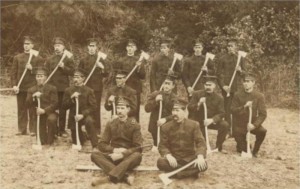
In this week’s edition of Civil War History in a Nutshell, I am going to talk about a group of soldiers instead of a battle movement: Colonel John Wilder’s Lightning Brigade. John Wilder was among the best of the volunteer officers in the Union Army. Before the war he owned a successful foundry (a factory that produces iron castings) in Indiana. Wilder invented many hydraulic machines that he patented, and he became nationally renowned as an expert in the field of hydraulics, patenting a unique water wheel in 1859.
At the beginning of the war, he turned his foundry over to the state to be used for the war effort and was commissioned as a Captain in the 17th Indiana Volunteer Infantry. By March, 1862, he had been promoted to Colonel and put in charge of the 17th Indiana Regiment. By the beginning of 1863, Wilder was in charge of a Brigade, which at that time included the 17th, 72nd and 75th Indiana, the 92nd and 98th Illinois and the 18th Indiana Battery commanded by Captain Eli Lilly (the later founder of the pharmaceutical company). Frustrated by being unable to swiftly follow fleeing Confederate Infantry, Wilder received permission from General Rosecrans to forage mounts for his brigade. The men took or bought local horses, mules, and donkeys – “anything with a back flat enough for a saddle that didn’t have horns” – and became mounted infantry. Under Wilder’s command, the brigade moved so quickly from one position to another that they became known as “Wilder’s Lightning Brigade.” Wilder also noticed how hopeless his men were with calvary sabers (most of them were farmers from Indiana) that he issued them hatchets instead.

During the long season that Rosecrans kept his army near Murfreesboro (after the Battle of Stones River), Wilder drilled his men. He soon had a regiment that was extremely well disciplined and could move very quickly from one objective to the next. Their firearms, however were a problem. Muskets were too hard to load while mounted, and the breech-loading carbines used by the cavalry were unwieldy and often jammed.
Wilder met Christopher Spencer in March 1863. Spencer had been touring the Army of the Cumberland to promote his new repeating rifle in hopes of a finding a major purchaser. The Spencer rifle had a tubular magazine that held seven rimfire, .56-caliber metallic cartridges. The magazine was inserted into the stock, and the rounds were fed into the breech by lever action. The Spencer rifle could fire 14 rounds per minute compared to the 2 rounds per minute fired by the standard-issue musket.
Wilder was stunned by the firepower of the weapon and decided to equip his brigade with them. When the Army declined buying them (because the soldiers would just “waste ammunition”), Wilder decided to buy them himself. Wilder took out a loan from his bank in Indiana and those men who wanted one signed promissory notes to buy them for $35. By May the new weapons were arriving and the men were ecstatic about the firearms. Now they could not only move quickly, but their firepower was such that it devastated and demoralized the Confederate units they faced.
Shortly after the Spencers began to arrive, the 75th Indiana, the only regiment that had not agreed to become mounted, was swapped out of the brigade in exchange for the 123rd Illinois, a veteran regiment eager to put spurs on their boots and mount up. In just a few months, the innovative Wilder had reshaped his brigade, changing it from a conventional group of line infantry regiments to fast-moving, rapid-shooting mounted infantry known as “Wilder’s Lightning Brigade” (info taken from history.net). As we learned last week, Wilder’s Lightning Brigade was instrumental in the Tullahoma Campaign and would continue to play a big part in the Battle of Chickamauga – next week’s installment of Civil War History in a Nutshell.

Pretty sure the men in the picture aren’t men of the Wilder Brigade, They appear to be firemen. Wilders men carried hatchets not axes, the caps are of a type not worn by the military in the Civil War. The jacket also doesn’t appear of a type worn by the Brigade. The caption says officers and NCO of the Brigade, but while there is one man with the shoulder boards worn as by officers none of the others show signs of wearing NCO stripes.
That makes sense. You are probably right. I shouldn’t believe all the captions I see on historic pictures. Thanks for taking the time to study the picture.